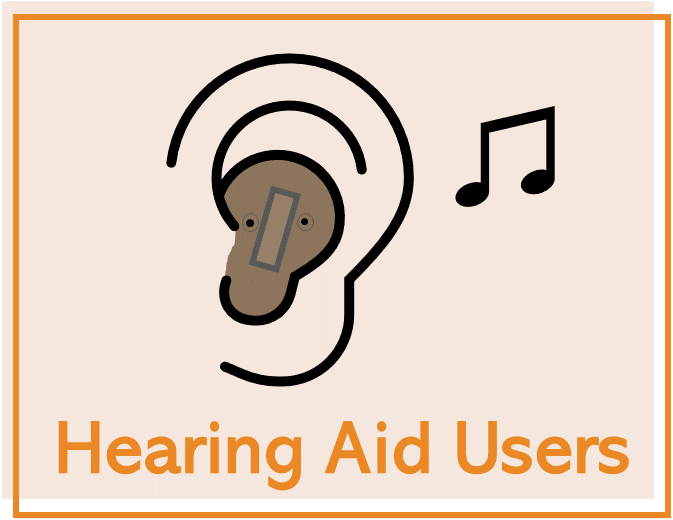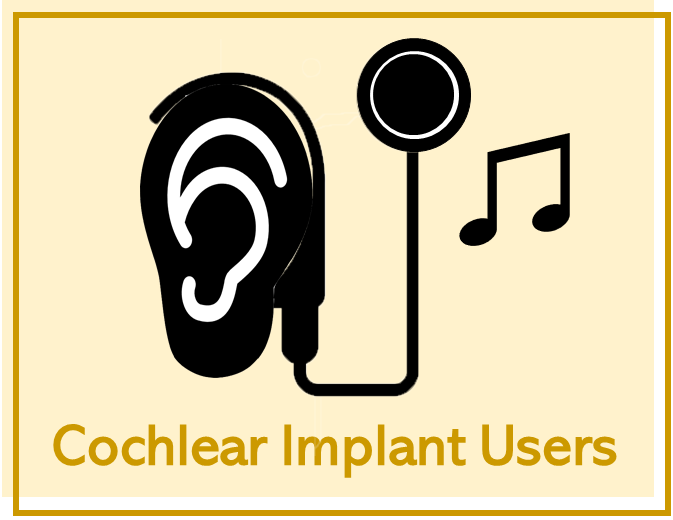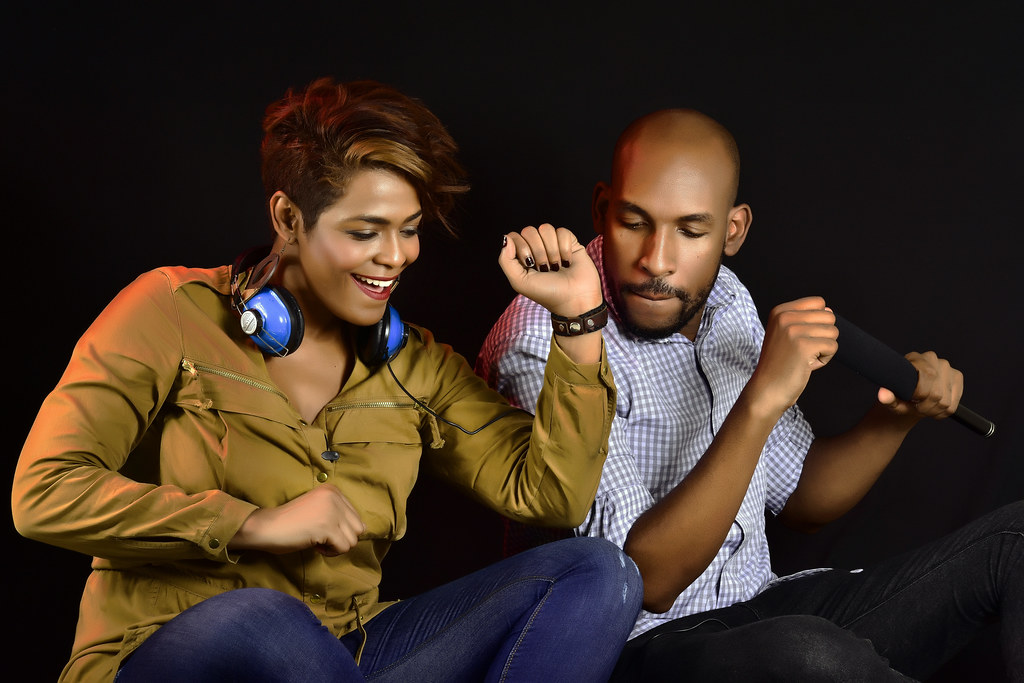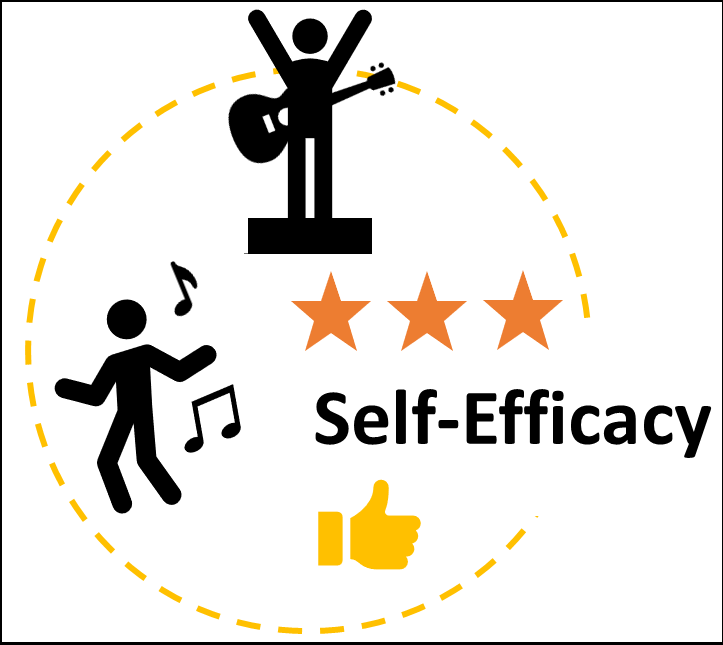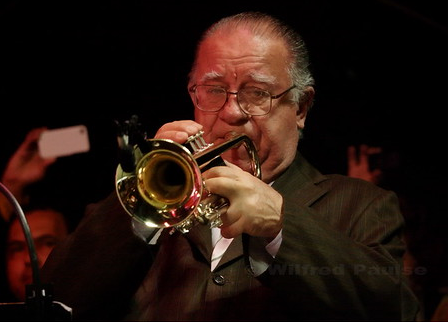See also: Articles on Music, Hearing Loss, and Hearing Devices
As you read this website, keep in mind the following:
-
People with hearing loss can differ in many ways.
-
Some information may be more similar to your situation.
-
Pick and choose the information most useful for you.
Music Enjoyment, Hearing Loss, and Self-efficacy:
Information for Hearing Device Users and Families
1, 2
Hearing aids and cochlear implants do not restore normal hearing. Unfortunately, music, in particular, can sound less enjoyable with hearing devices. Losing the beauty and pleasure of music can contribute to feelings of loss, frustration, and social isolation.

Q. Is there anything the listener can do to improve music experiences?
A. Yes, we hear not only with our ears but also with our brains and our attitudes.
-
Unfortunately, there are no easy 'fixes' to make music sound just the same as before hearing loss.
-
However, people with greater self-efficacy and perseverance can re-establish greater music enjoyment.
-
Self-efficacy is one of the important determinants that helps to cope with the loss of musical enjoyment after hearing loss.
-
Q. What is self-efficacy?
A. Self-efficacy is a human trait in which people feel confident about their ability to take action as needed in future situations.
-
Self-efficacy is domain-specific; that is, people may feel more confident about some aspects of their life than others.
-
For example, one person may feel confident in athletic challenges but insecure in cooking, or vice versa.
-
-
Specific to hearing loss, a person with strong self-efficacy feels confident that they can find ways to
-
communicate successfully,
-
manage their hearing devices,
-
overcome challenges, such as listening to music!
-
-
People with stronger self-efficacy tend to get greater benefit from their hearing devices.
-
Self-efficacy can help people with hearing aids and cochlear implants to find beneficial strategies for enjoying music and communicating in complex environments.
People who have high levels of self-efficacy tend to have the following traits:
Self-motivation
-
Self-motivated to seek out useful hearing devices and support from hearing professionals.
-
Accepts input and encouragement from family members and friends to make the most of their hearing and hearing devices.
-
Tend to be more satisfied with their hearing aids.
-
Actively looks for music that sounds pleasant despite their hearing loss.
-
Tries Assistive Listening Devices (ADLs) to listening.
-
Searches for resources on music and hearing devices.
-
Practices listening and tries more challenging musical sounds.
Positive attitude
-
Acknowledges having a hearing loss, while believing that they can find strategies to improve listening.
-
Finds benefits from hearing devices rather than focusing only on the limitations.
-
Feels proud of developing new listening skills.
Personality traits
-
Has an open mind. Is willing to try new things and experiment.
-
Sets up practical routines for using hearing devices, assistive listening devices, and practicing.
-
A higher internal locus of control – the belief that you can control or influence your behaviors and your environment.
Seeks expert input
-
Goes to audiology appointments with questions about how to enhance musical and spoken communication.
-
Asks about assistive listening devices and programs that might enhance listening. [Click here to learn more about assistive listening devices]
-
Looks for community or online user groups and training programs. [Click here to learn more about music training]
Q. Can people improve self-efficacy?
A. Self-efficacy can be increased by four main sources (Bandura, 1994):
-
Mastery experiences
-
Vicarious learning
-
Verbal persuasion
-
Emotion
Mastery experiences
-
Practice music listening or music making, but pick your challenges carefully. Structure practices that increase success and reduce the chances of failure.
-
Simpler tasks tend to include musical sounds that are easier to hear through a hearing device, such as musical rhythm, or familiar music.
-
Gradually increase the difficulty of listening tasks.
-
Initially practice in easy listening environments that you can control.
-
-
Remember that music listening is a dynamic, multifaceted phenomenon, with musical combinations, environmental factors, and the listener’s internal state changing over time. (Click here to view what factors impact music experiences of CI users).
-
Here are some strategies that can be helpful to improve music listening through cochlear implants and hearing aids:
-
Click here to learn more about how different musical sounds affect music listening and strategies for music listening.
-
Click here to learn more about how the listening environment affects music enjoyment and strategies.
-
Click here to learn more about how other factors impact music listening and strategies.
-
Click here to learn more about tips for listening to music through hearing aids
-
Vicarious learning
-
Participants observe the actions of others and gain an objective understanding of what works. Observing role models boosts motivation and to try challenging tasks.
-
Witnessing successful completion of a task by others can also bolster the clients’ belief that they too can succeed!
-
This is particularly powerful when clients observe those who are similar to them with sustained success.
-
Example: if CI recipients watch that their friend with a CI asks a waiter at a noisy restaurant to turn down the background music and resolve a difficult communication situation effectively, they might also think, ‘Hey, I can do that too!’
-
Verbal persuasion
-
Positive feedback from others such as loved ones, audiologists, and therapists can also have a positive impact on a client's self-efficacy.
-
Verbal persuasions include encouragement and praise from others.
-
Verbal persuasion is more effective if given by a credible and trustworthy person.
-
-
Verbal persuasions can also be self-directed.
-
Set aside a few minutes each day to praise yourself and repeat affirmations like – “I am trying hard”, “I can overcome this,” “Today, I was able to recognize the sound of the piano for the first time!”
-
Irrespective of our talents, success, and failures, we can develop greater self-confidence and continue seeking better results.
-
Emotional state
-
Emotions and physical states play an important role in one’s self-efficacy.
-
Mood, physical responses, and stress levels can all impact clients’ motivation, energy level, and how they feel about their abilities in different listening situations.
-
Try harder listening tasks when you are feeling more rested and at ease.
-
-
Music listening requires effortful or attention and can cause fatigue.
-
Mental overload, and emotional frustrations can occur in noisy and tiring listening conditions.
-
Pick and choose situations carefully; start with less noisy or complex situations or try challenges when you are more alert.
-
Don't just avoid all social situations; that can lead to social isolation and sadness.
-
-
Take an occasional break from a noisy or tiring situation.
-
-

References:
Ferguson, M. A., Woolley, A., & Munro, K. J. (2016). The impact of self-efficacy, expectations, and readiness on hearing aid outcomes. International Journal of Audiology, 55(sup3), S34-S41.
Gfeller, K. E., Driscoll, V. D., & Schwalje, A. (2019). Adult cochlear implant recipients’ perspectives on experiences with music in everyday life: A multifaceted and dynamic phenomenon. Frontiers in Neuroscience, 13, 1229.
Gfeller, K., Mallalieu, R. M., Mansouri, A., McCormick, G., O’Connell, R. B., Spinowitz, J., & Gellinek Turner, B. (2019). Practices and Attitudes That Enhance Music Engagement of Adult Cochlear Implant Users. Frontiers in neuroscience, 13, 1368.
Meyer, C., Hickson, L., & Fletcher, A. (2014). Identifying the barriers and facilitators to optimal hearing aid self-efficacy. International Journal of Audiology, 53(sup1), S28-S37.
McMullan, A., Kelly-Campbell, R. J., & Wise, K. (2018). Improving hearing aid self-efficacy and utility through revising a hearing aid user guide: A pilot study. American journal of audiology, 27(1), 45-56.
Smith, S. L., & West, R. L. (2006). The application of self-efficacy principles to audiologic rehabilitation: A tutorial. American Journal of Audiology.
Smith, S. L. (2014). Promoting self-efficacy in patient-centered audiologic rehabilitation for adults with hearing loss. Perspectives on Aural Rehabilitation and Its Instrumentation, 21(1), 24-32.
Smith, S. L. (2019). The role of self-efficacy in the audiologic rehabilitation process. In J. J. Montano & J. B. Spitzer (Eds.), Adult audiologic rehabilitation (pp. 265-280). Plural Publishing Inc.
Vestergaard Knudsen, L., Öberg, M., Nielsen, C., Naylor, G., & Kramer, S. (2010). Factors Influencing Help Seeking, Hearing Aid Uptake, Hearing Aid Use and Satisfaction With Hearing Aids: A Review of the Literature. Trends in Amplification, 14(3), 127-154.
Click here to review references used in preparation of this website.
1. All images on this website are used under Creative Commons or other licenses or have been created by the website developers.
2. Click here to access the sources of images on this page.
